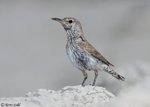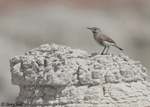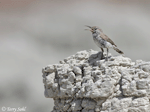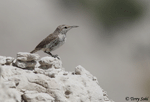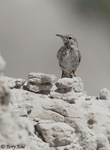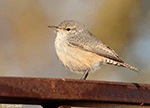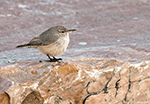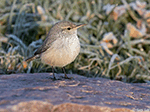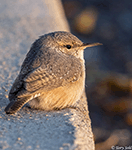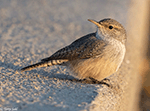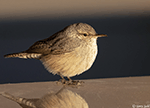Rock Wren
Salpinctes obsoletus
| Length: 6 inches | Wingspan: 9 inches | Seasonality: Summer |
| ID Keys: Pale brown lightly speckled upperparts, white underparts with finely streaked breast, rust colored undertail coverts | ||
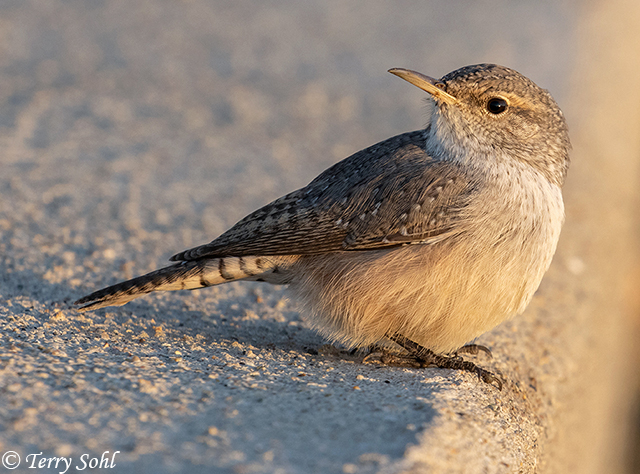 The Rock Wren is a pale wren of arid rocky slopes and
canyons. In South Dakota, their primary haunts are the arid rocky areas of
western South Dakota. They are known for often constructing a thin trail of pebbles leading to
its nest in crevice or hole. Residents of arid habitats, Rock Wrens are not known to
drink water, instead getting all required moisture through food items.
The Rock Wren is a pale wren of arid rocky slopes and
canyons. In South Dakota, their primary haunts are the arid rocky areas of
western South Dakota. They are known for often constructing a thin trail of pebbles leading to
its nest in crevice or hole. Residents of arid habitats, Rock Wrens are not known to
drink water, instead getting all required moisture through food items.
Habitat:
Rocky slopes and outcrops, canyons, cliff walls, and reservoir rip-rap, usually in arid locations.
Diet:
Insects and spiders.
Behavior:
Forages on the ground, often probing cracks and openings with its bill. Will also forage low in bushes or low trees. They typically glean insects from the surface of rocks or vegetation, but will also make short fluttering flights to grab prey in mid-air. They also have been seen picking insects from spiders' webs.
Nesting:
June and July in South Dakota. The nest of a Rock Wren is placed in a rock cavity or crevice, or occasionally in a man-made cavity. The nest is placed deep in the cavity, and is constructed of twigs and grasses, with other material such as leaves, roots, bark, or moss. The nest is generally lined with softer material such as hair, spider silk, feathers, or fine grasses. Often they build a "sidewalk" of small pebbles that leads away from the nest and often out from the cavity or crevice for some distance. The female lays between 4 and 9 eggs, and she alone incubates them. The young hatch after about two weeks, fledging from the nest about another two weeks after hatching.
Song:
The song of a Rock Wren may consists of rapid trilling, with tone and tempo sometimes shifting between songs. Songs also sometimes include more musical notes followed by trilling. Overall, even one individual Rock Wren may have a very large variety of songs. The call of a Rock Wren is a sharp chek.
1Click here to hear the trilling song of a Rock Wren
2Click here to hear the calls of a Rock Wren
3Click here to hear the scolding calls of an agitated pair of Rock Wrens
Migration:
Populations in the northern half of the western U.S. move southward in the fall. Southwestern populations generally permanent residents.
Interactive eBird map:
Click here to access an interactive eBird map of Rock Wren sightings
Similar Species:
Habitat distinguishes where many wren species are found, and that includes the Rock Wren. However, some wren species are similar in appearance to the Rock Wren and may sometimes be found in the same general vicinity.
- House Wren - House Wrens are normally found in different habitats than Rock Wrens, with House Wrens found in thickets, woodland edges, riparian areas, and other areas with vegetative cover. Rock Wrens are normally found in arid, rocky areas. In appearance, Rock Wrens have speckling on the back and wings that's generally lacking on House Sparrows. Rock Wrens normally have a buffy color on their lower belly that's lacking on a House Sparrow.
- Winter Wren - Winter Wrens (and their recently split relative the Pacific Wren) have some similar characteristics on their upperparts as a Rock Wren, but are heavily spotted on their underparts while a Rock Wren has clean underparts. Winter Wrens are also generally found in thick cover, as opposed to the open rocky habitats of Rock Wrens.
- Canyon Wren - In terms of habitat, Canyon Wrens are the most likely wren species to be found in conjunction with Rock Wrens. On appearance, they're quite different, as Canyon Wrens are a darker warm brown overall, compared to a lighter brownish-gray for Rock Wrens. Canyon Wrens have a bright white throat that contrasts strongly with face and head, while the Rock Wren has much less contrast.
Conservation Status:
Generally stable throughout its range, although some sources indicate a slight decline in recent decades. They are found across a broad geographic region and are common in many parts of their range. The IUCN considers the Rock Wren to be a species of "Least Concern".
Further Information:
Photo Information:
October 14th, 2019 - Good Earth State Park, South Dakota - Terry Sohl
Audio File Credits:
1Scott Crabtree. Recorded in Pima County, Arizona on February 19th, 2020. Original recording and information from xeno-canto.
2Peter Boesman. Recorded in Madera Canyon, Arizona on February 16th, 2007. Original recording and information from xeno-canto.
3Andrew Spencer. Recorded in Saguache County, Colorado on May 29th, 2012. Original recording and information from xeno-canto.
| Click on the map below for a higher-resolution view |
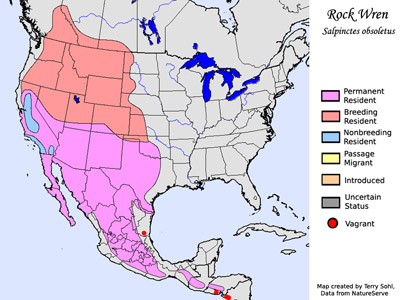 |
| South Dakota Status: Common migrant and summer resident in the western third of the state. Rare further east. |
Additional Rock Wren Photos
Click for a higher-resolution version of these photos
